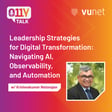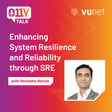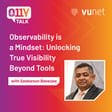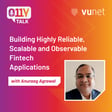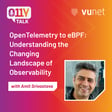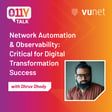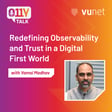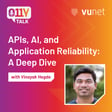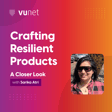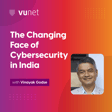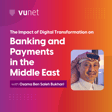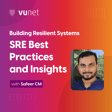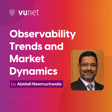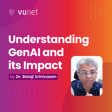Building Trust through Transparency
00:00:00
Speaker
I mean the whole banking is built on customers trust right? So how do you give them the trust? ah If you're able to give them complete transparency in terms of where your transaction is, ah what is the stage it is, where are we in terms of processing it, has it been completed?
00:00:17
Speaker
So you have the in three dimensional, I would say, right? your Your enterprise architecture, your infrastructure, and then your application. So you need to have this observability platform if you really want a 360 degree view.
00:00:30
Speaker
ah We call it the customer static data, right? Because this data, you obtain it only once when you onboard the customer. Correct. Let's say, for example, I have onboarded a customer 15 years ago. Right? I don't validate that data again.
00:00:43
Speaker
But I have migrated to a new core banking. I have come up with a new mobile banking. I have come up with an internet banking. So this data gets... translated to different systems, you end up with something else completely than what the customer had actually provided. So I think this is where the data governance, data quality, you know, I think you need to have a central team which manages that.
The Evolution of Digital Transaction Banking
00:01:18
Speaker
Welcome to a new episode of Observability Talk. Banking has undergone a dramatic transformation in the last few decades. Today, payment platforms enable the seamless movement of money and banking is increasingly reaching every corner of the globe.
00:01:35
Speaker
In this episode of Observability Talk, I am excited to host K. Subramanian, a seasoned banking leader with over 30 plus years of experience shaping the future of transaction banking, structured trade finance, and digital banking innovation.
00:01:51
Speaker
Subrabhaniam has led multi-million dollar businesses and transformed banking operations across Middle East. He was key in launching the UAE Trade Connect platform, pioneering transaction banking at the National Bank of Fujairah, and advancing corporate client onboarding and loan origination.
00:02:10
Speaker
Hi Subrabhaniam, a warm welcome to your observability talk. Good morning. How are you? Yeah, thank you so much. I'm doing great. ah So ah let's start from the beginning.
00:02:22
Speaker
ah See, you have been involved with transaction banking. Can you please explain what is transaction banking and how has it evolved over time? Yeah. ah So transaction banking basically refers to the suit of financial services that it has got three verticals.
00:02:41
Speaker
ah One is facilitating the cash management or the flow of payments, ah liquidity. That is one stream. The second stream is trade finance, ah which facilitates cross-border as well as domestic trade.
00:02:55
Speaker
And the third stream is security services. ah Over the last 10 years, what has happened is there is a fourth stream, which is basically the channels, the digital enablement is also part of that.
00:03:08
Speaker
ah So in cash management, primarily it is about liquidity, collections, payments, what kind of pooling structures you have depending on the businesses. It's basically about businesses, how do they manage their cash flow, how do they manage their liquidity, how they move funds ah within the country, outside the country, cross-border, payment solutions to their suppliers, collection from their buyers, those kind of solutions fall under the cash management piece.
00:03:36
Speaker
In trade finance, obviously, people are familiar with letters of credit, guarantees, various supply chain finance, ah cross-border. You know, if they are like a big trader, commodity trader, there's cross-border trade happening across countries.
00:03:51
Speaker
So that crop but predominantly falls under trade finance. And the third piece is the security services, like custody services, clearing, financial assets for institutional clients.
00:04:04
Speaker
So those are the three main streams. And over the last 10 years, what has happened is with the digitalization coming in, ah it's the channels, how you integrate customer platforms with your platform, you know, that has become a kind of a forte by itself ah because technology has also evolved over time and the customer requirements have ah changed over this period.
00:04:27
Speaker
So if I say that this is more for businesses, not for retail sort of customers, because you talked about ah various type of services which are available for these customers.
00:04:39
Speaker
So it's it's more focused towards businesses. Is that um summarization correct? Yes, ah largely to businesses, but it is also used by consumers. It is also used by other financial institutions.
00:04:52
Speaker
It is also used by governments. So anybody who's got liquidity, like like for example, ah for retail, it might be more simplified version, right? It could be ah like just having an account.
00:05:03
Speaker
I mean, let's say, for example, personally, we have four accounts. We maintain balances in different accounts. Investment could be, you know, from a consumer perspective, investment could be in one account. ah His ah debt could be in another account.
00:05:16
Speaker
is ah Let's say, for example, DMAT in India could be with another account. So how do they manage the flow between that, their collections, their payouts, you know, let's say the insurance premium. So it is also applicable, but kind of in a smaller version or a more simplified version for consumers as well.
00:05:34
Speaker
and and These applications, because obviously ah banks would have different different applications to cater to each of these services, ah the way you are trying to explain it, looks like that these applications also talk to each other, ah interact with each other ah to provide specific services?
00:05:53
Speaker
Correct. so So if you see, banking is kind of very archaic, right? I mean, it's ah it's an old business. So typically, these um services were offered independently to customers.
00:06:05
Speaker
But I think ah once we had the ah in internet era, people want to bring it together. Like I don't want to go to a bank to do just clearing or issuing checks with one bank or do my payments with another bank. So I want to kind of bring all of this together.
00:06:21
Speaker
So that's where the internet banking, I mean, if if I just have to give you the evolution of transaction banking, pre 90s, it was typically paper-based. ah People used to come in, write a check or people used to come in and write a payment request.
00:06:36
Speaker
Whereas if you see in the 90s and the 2000s, the last, ah yeah let's say 20 years, a lot of digital ah payments, mobile banking, ah real-time settlement, ah instant payments, those have become very popular.
00:06:52
Speaker
And also, corporates... ah when they had their enterprise ERPs, they don't want to get involved in coming to a bank's portal to do their payments, right? They want to do everything from their yeah ERP.
00:07:04
Speaker
They want a connectivity to the bank's portal, which will then process the payments. So there are multiple solutions like host-to-host, APA-based banking. ah So in the last five years, what has become quite the demand from the customers or the corporates or the customers is...
00:07:23
Speaker
ah how do they ah do more quicker, faster, real-time payments? I mean, ah with but other social media and all that, they get so used to these, you know, kind of instant service things. So they're expecting banks also to kind of catch up with that ah kind of trend.
00:07:42
Speaker
ah The future is quite exciting, I would say. ah There's a lot of things that are happening. People are using, banks are using generative AI for handling customer service. ah Earlier, it used to be call center, the conventional you know ah back office handling all the queries.
00:07:58
Speaker
Now, it is more Gen AI, more ah instant payments coming through. ah Banks are using a lot of ah data analytics to hyper-personalize, make offers to customers.
Digital Currencies and Embedded Finance
00:08:12
Speaker
ah One of the recent trends that I'm seeing across central banks is the yeah central bank digital currency. I think RDA has come out with that. Correct. A lot of central banks are coming up because what's happening is, apart from the consumer payments, there are a lot of bulk heavy payments that are made by governments, by institutions.
00:08:33
Speaker
ah you know, for them, they need to come up, you know, for them, the cost has to be low and the settlement has to be quick and they don't want intermediaries, right? Because i if yeahka yeah if typically a company A has to make a payment to a company B cross-border, there are minimum of at least two or three intermediaries involved.
00:08:53
Speaker
Whereas if a government or a central bank is settling between two countries, they want it to be real-time, they want it to be low-cost, right? Because these are high value payments, right? They want to see real-time credit.
00:09:04
Speaker
That's where these central bank digital currency or blockchain-based platforms become quite ah important. And that's something that is evolving. I think most of the central banks are kind of talking about it.
00:09:15
Speaker
ah The last piece which is ah very useful for corporates is the embedded finance, right? So ah you you have a lot of corporates and fintechs working together.
00:09:27
Speaker
Right. So let's say, for example, if somebody is running a retail store for apparel, ah he wants to give a choice to his customer. Right. So this will help them to do that.
00:09:39
Speaker
Similarly, buy no pay later kind of solutions at the POS. So these are developing kind of ah technologies that are, you know, trying to match what the banks are trying to do.
00:09:52
Speaker
Yeah, so there are a lot of action happening on the fintech side of things, like you said, BNPL. And then there are lot of other terms which has been coined in last four, five years with the respect to ah what kind of services these banks and fintechs together can provide.
00:10:09
Speaker
These are very interesting, the way you talked about something from an IT era where everything was moved in paper to now something which is much more digital. People want things faster, better, maybe quicker um in terms of the banking. The expectation itself has reached to a place that, okay, I want it now and I want it Right.
00:10:31
Speaker
right So see, see, customers are actually comparing ah banks. Let's say, for example, my experience in ordering something over Amazon or streaming something on Netflix, you know, the kind of user experience that you get, they get in these platforms.
00:10:46
Speaker
ah They are expecting the banks to catch up and provide the same kind of ah customer experience. So I think it's important for banks also to kind of, you know, upgrade themselves and catch up. Very true.
00:10:57
Speaker
So ah I can tell you for sure that in India, we are seeing a lot of action on this side. I mean, the amount of fintechs which has come out to provide some of these services and the banks who is basically continuously upgrading their infrastructure, ah coming out with newer applications, ah like you talked about, right, that for corporates, for retails and so on.
Fintech Disruption in the Middle East
00:11:20
Speaker
oh How you have seen it in Middle East because you have been ah in Middle East for a longer time, right? And you have been part of this whole banking journey there. How you have seen the evolution of these technologies or these ah sort of fintechs and services in Middle East?
00:11:38
Speaker
So I think in the Middle East, you know, the traditional banking has been prevalent till say about 2005, 2010. two thousand five two thousand ten I think that's when the real digital banking, ah internet banking, corporates doing host to host has evolved.
00:11:57
Speaker
ah But I think one one big advantage in the Middle East is ah even as the government's are trying to focus on these, right?
00:12:07
Speaker
ah So let's say, for example, whether it's the UAE Central Bank, they're focusing on real-time payments. They launched something called ANI. ah If I have to put a parallel, it's similar to your UPI in India, right? but What they did there in India.
00:12:21
Speaker
So they have they have that payment. ah Saudi has got its own Saudi payments. All the GCC countries are coming together to do a real-time settlement because there's a lot of ah businesses that operate in the Middle East. There are a lot of government transactions that happen.
00:12:38
Speaker
So for this but within the GCC, they are launching something called an AFAC system. And like I mentioned earlier, the ah the central bank digital currency, because ah there's a lot of settlement that happens between the GCC countries, right?
00:12:52
Speaker
Now, they are trying to roll out ah central bank digital currency. Now, for example, UAE central bank has got a project called Enbridge, which is basically a multi-currency blockchain based cross-border platform.
00:13:07
Speaker
Very nice. Right. So that is something that they have built and it's it's going to come out very soon. So there's already a plan for how they're going to roll out. um Similarly, i mentioned about BNPL on the consumer space, right, which is buy now, pay later.
00:13:23
Speaker
ah That is becoming very popular over the last few years. And this place is actually being disrupted by a lot of the non-bank, you know, fintechs. So actually, if you see, the fintechs are the challengers for banks.
00:13:38
Speaker
It's not banks competing with banks. I think more or less, if if you actually look at ah various banks, whether it's the big banks, the tier two banks or the smaller digital banks, right? See, the digital bank is more focused on the consumer side of it.
00:13:53
Speaker
So we have three digital banks that have been launched in the last few years in UAE, for example. ah yeah Bahrain similarly has got a digital bank.
00:14:04
Speaker
Saudi has also got a few a few of them. So digital banks are something that is ah becoming very popular. ah They don't have any outlets. I mean, I'll give you an example, right? Some of the big banks in the UAE, they used to have 50, 60, 70 branches.
00:14:20
Speaker
Now they have all been shrunk. They have all become a digital experience center for customers. ah right So people are moving away from that typical branch banking to digital banking, mobile banking.
00:14:34
Speaker
so So the banks are calling it experience centers. it's It's like a cafe. You go there, you do your banking stuff, you meet your advisor, whatever bank requirements. So it's not your typical bank setup.
00:14:48
Speaker
So that is something that is happening. And what we have seen also in the Middle East is there's a lot of fintechs that have entered this market over the last... ah let's say, five years, right? ah Whether it is relating to embedded finance for the SME space.
00:15:03
Speaker
See, because SME space, I think if you look at the UAE market or the Saudi market, SMEs play a very important role in the economy. Right. ah there's There's a study which says about 50 to 60 percent of the local businesses are SMEs and that's a contribution to the economy.
00:15:21
Speaker
Right. So ah some of these are actually being ah targeted by these s fintech companies to serve them. right Because some of them cannot avail, let's say, a bank financing.
00:15:33
Speaker
So the fintech companies are working with them to try and help them do, ah let's say, embedded finance or you know buy now, pay later. right ah The other important area where there is a lot of development in the Middle East is the regulatory technology.
00:15:51
Speaker
What I mean by that is ah money, anti-money laundering, sanction prevention. So there's a lot of focus on um automating those ah activities, right?
00:16:01
Speaker
So like like in my previous organization, we deployed a ah yeah sanctions payment screening tool, ah which was based on AI. Right. So we used to set up certain rules.
00:16:13
Speaker
ah Every payment, inward and outward payment would get tracked. It gets flagged off if it matches a particular threshold and then you screen those payments. So right you don't have an army of people sitting back and reviewing every payment. Right. So this is like, ah you know, it throws out the false positives.
00:16:30
Speaker
You keep fine tuning the rules. So these are automated fraud prevention. And similarly, ah you know, fraud prevention, whether it is, ah let's say, at the credit card level or at the account payment level. So, those automations are also being, so the central bank regulations are kind of getting um upgraded to ah bring it ah you know bring more automation into this area.
00:16:52
Speaker
and mr er So two key things that are very, very recent is ah something called open finance. So the UAE Central Bank has actually rolled out the regulation on open finance.
00:17:05
Speaker
ah The intention of this is to kind of ah make a standard trust framework. Okay. ah ah Consent platform so that, ah you know, there is a consistent way of seeking consent from consumers.
00:17:21
Speaker
ah Second, making some standard API hubs so that the banks can use that. ah Basically, it's like an intermediary step towards getting into open banking if you want to, you know, put it that way.
00:17:34
Speaker
ah right ah Similarly, they also launched a local domestic scheme. Like, I mean, another example of that is similar to Rupe. So there's a lot of, yeah, similar to Rupe. Similar to Rupe, it's called J1.
00:17:48
Speaker
ah This is the central bank domestic scheme. Now, the best part here is they do both ah the local domestic payment as well as they have tied up with people like UnionPay, Master Visa for cross-border as well.
00:18:02
Speaker
Okay. Okay. So so there's there's a lot of ah developments that are happening. And of course, ah big things like UAE Pass, which is the digital identity, has been there for some time. So UAE Pass is actually used across all... ah It's not only banking, it's used even for, let's say, for your telecom connections, for your utility bills, ah you know, immigration at the airport. So there's a lot of ah digital identity that is being used.
00:18:31
Speaker
ah So, those are the focus areas or innovations, I would say. But having all this means you need to also have appropriate cybersecurity, resilience and all that. so Very true.
00:18:43
Speaker
that That's where the investments are actually going in right now. This is very interesting to know. Some of the things which you mentioned about like digital banking, we have been hearing a lot about new banks.
00:18:55
Speaker
where I do not have anything on my own, but I still provide all possible banking services to my customers, right? ah You talked about open finance. That is very, very interesting because ah the whole new era actually is era of APIs, right?
00:19:11
Speaker
ah People are basically connecting or interconnecting with almost anybody and everybody, ah which will help provide specific services to their end customers. So, yeah. Ed customer being the focus that, okay, these are the services which I should be able to render to them.
00:19:27
Speaker
Let's figure out who should I interconnect or who should I ah talk to, to get those services and provide them. And it's also important, you know, the financial and the non-financial, how do we bring them together?
00:19:41
Speaker
Very true. Very true. so So these are some of the things which India has been trying and that they are quite successful in some of them. ah Starting with UIDI, then UPI, then ONDC, their account aggregator.
Global Digital Transformation Lessons
00:19:55
Speaker
ah There are a lot of work which is happening with respect to ah financial inclusion at the lower most level.
00:20:03
Speaker
ah as well as cashless economy, like you talked about CBDC sort of thing. And I think ah the future looks to be ah very drastic from all these angles.
00:20:17
Speaker
Like how how will it make people's life easier, simpler, and things will become easily accessible to to the lower most in the pyramid, right? Yeah.
00:20:29
Speaker
So just ah taking this a little forward, so you have been, ah during your tenure in Middle East, you have been involved in multiple digital transformation initiatives, right?
00:20:42
Speaker
So I just wanted to i understand ah what are the top three lessons or challenges if you want to talk about ah you have learned over these years that you have done some of these very critical as well as complex digital transformation projects.
00:20:59
Speaker
Right. So, i just just in terms of perspective, I'll tell you, I've been part of three ah core banking rollouts. Okay. Three ah in in in the last three decades.
00:21:09
Speaker
ah Three internet banking rollouts. ah so So it's it's been, i mean, you know how core banking, how critical it is for banks, right? And you banks are generally hesitant to kind of upgrade or um change their core banking because it's like the engine, right? So they don't want to touch that engine.
00:21:28
Speaker
So what I've seen, you know, there are three big Themes I usually see, ah the first and foremost being, ah how does the digital transformation align with the business business goals of the organization, right?
00:21:41
Speaker
Right. It's important ah that it ah whatever spend you do on the digital is actually aligned with the business goals. You know, ah like I mentioned about neobanks, is my focus on ah onboarding customers digitally.
00:21:55
Speaker
So then the spend goes into that. Is my focus on operating efficiency? So whatever is the business goal of the organization, it should be aligned with that. And along with that comes the sponsorship from the leadership.
00:22:08
Speaker
Right. So ah that is very important as well. You know, the the outcomes, we should have specific KPIs outcomes to be measured. You know, is it improving my customer experience, my net promoter score?
00:22:22
Speaker
Is that going up? How am I bringing operating efficiency? Like I have been part of one particular transformation ah where we brought down the direct cost by 70%.
00:22:34
Speaker
for processing a transaction, right? So it's like 70% reduction in operating cost of a particular transaction. So if I look at a payment ah over the last, let's say, 8 years, ah the cost has come down by 70%. So that is all ah kind of result of the automation. So these are kind of specific metrics or KPIs that the management would like to see, right?
00:22:56
Speaker
So also where we have seen it has been successful, the positive side of it is When leaders are engaged, are we ah when leaders are actually kind of championing the change and fostering this digital culture, ah the adoption is also heavy, right?
00:23:13
Speaker
ah like Like, for example, we've run several hackathons. ah The staff come up with ideas. The people who are doing the activities actually come up. You know, wama why am I taking three hours to do this activity?
00:23:25
Speaker
If I have this tool, I can complete it within 45 minutes. and know For example... ah we We did an implementation where it involved documentary, you know, export document checking. This is typically the most manually intensive work that can happen in a bank.
00:23:42
Speaker
And generally banks don't, ah there there are not enough tools to kind of automate this. So typically what we have seen is there is hesitancy, but we actually don't,
00:23:54
Speaker
kind of found a partner ah who could review this document. So for example, what was happening is if a customer had submitted an export document under a letter of credit, the bank would typically take, you know, six to eight hours to review the document and go back to the client on the status, right? If there is ah any discrepancy, if he needs to submit anything.
00:24:12
Speaker
We reduced it to actually 45 minutes. So one, the customer experience has gone up. So ah what i why I say that is the... the The leadership, how the directional leadership is very important in how people within the bank come up with ideas, people within the bank kind of change themselves.
00:24:32
Speaker
You know, there will always be resistance in certain pockets, but you address that through training, communication. that's the That's the biggest thing. so So business goals, business leadership is the kind of first lesson that is very important for any digital transformation.
00:24:48
Speaker
The second is being more focused outside, right? So what is the customer saying? What does the customer need? like ah Generally, what happens is, oh, I am investing so much cost. How do i improve the efficiency? Rather than that, look at, you know, if I if i fill a customer need, can I scale up my business?
00:25:06
Speaker
ah Can I double my business? I mean, that's the kind of challenge. Again, it is tied into the... you know, the first point that I said, the business goal and the business leadership, right? ah So ah customer focus.
00:25:17
Speaker
I mean, for example, banks are now competing with, let's say, the social media platforms. right So we have to be nimble enough to see customer inputs, customer insights, what kind of data we can use, the customer transaction behavior, how do we use that.
00:25:33
Speaker
ah right So those ah those will significantly improve the way digitalization works within our organization. Right. ah This also, ah like we have been part of a solution where we have allowed customers to co-create solution, right? We've made a kind of a and MVP, showed it to customers.
00:25:52
Speaker
ah Customers give inputs to that. So they co-create the solution. What happens is when they do that, they become very engaged. So for you enhance the net promoter score from a customer perspective, which is very important for a bank.
00:26:06
Speaker
The last piece is allowing people to experiment, right? So typically what happens is when there is a cost, people want to see what is the outcome, you know? Am i able to reduce my staff cost? am I able to reduce my operating cost?
00:26:19
Speaker
But sometimes it is also good to experiment. So allowing people to kind of do small experiments then scaling it to an organization-wide, that is what has been successful. So in cases where we have seen ah successful rollout of some of these ideas is where we have taken a small pocket of an organization, ah tested out a minimum product, and then kind of scaled it across the organization. So what happens is this then gets...
00:26:48
Speaker
scalability, flexibility, ah you get interoperability between different solutions. ah You know, those kind of things come into play when you go to a wider organization-wide solution.
00:27:00
Speaker
So we should not just be, you know, just changing tech for the take-offs, you know, being the technology or the digital transfer. Oh, I have a good OCR tool, so let me use that. But what is the solution that we are actually looking at, right? What are we like what is the problem that they're solving?
00:27:16
Speaker
So I think that is, the these are the three three things. And the last important point is digital transformation is a journey, right? You don't you don't do a one-time investment and say, oh, now we are digitally transformed. It's journey that continues across the life of the organization.
00:27:31
Speaker
No, no, very, very true, Subhanian. ah One thing which basically really resonated with me was the first one, that you have to all align everybody to what we are trying to achieve because change is very painful, right? A lot of people generally...
00:27:49
Speaker
are very and not not that ah easy to change, right? So until you really align people and get them into a single goal, it becomes difficult to implement some of these transformation initiatives.
00:28:04
Speaker
The second part which you talked about was very interesting because ah finally the digital transformation is being done to make sure that customers get better user experience or customers' experience is better or whatever we are delivering to them.
00:28:19
Speaker
ah It's something better than what they have been getting so far. right So this is something which we have seen in Most of of our projects where every digital first business is now started looking at how their end user experience is.
00:28:32
Speaker
Right. And my next question is going towards that terms of transaction banking. Right. And trade finances. These basically are playing very critical role in global e-commerce or commerce. Right.
00:28:46
Speaker
How do banks ensure resiliency, real-time visibility into the these applications' performance, transaction failures, um maybe latencies, and the fraud risks, right?
00:29:00
Speaker
ah They have to have some visibility into these challenges. How do they take care of, do how do they do it today? See, so far, I mean, what I have seen over the years is the banks have been using conventional methods.
Enhancing Customer Experience in Banking
00:29:13
Speaker
So you have an app support team, which is sitting like a control room, monitoring all the applications, they are you know the interconnectivity with the external, whether it is SWIFT or whether it is FedNow or whether it is the central bank system, subscribing to alerts coming from different systems.
00:29:32
Speaker
So that worked ah getting notification from, you know, the central bank alert system or your own system. So that was the conventional method that the banks were using.
00:29:44
Speaker
ah And in terms of AML, like I mentioned, right? So recently we implemented, last year we implemented a AI based, machine learning based platform, ah which was actually screening payments for sanction compliance.
00:30:00
Speaker
ah Similarly, trade finance payments are being screened for sanction compliance. So that actually gives you a dashboard. Let's say if I have two and a half thousand payments coming in, ah you know, two thousand have been auto cleared.
00:30:12
Speaker
These are the results. These are the parameters based on which they have cleared. So have complete visibility over at what stage the payment happens. So there are tools that are being used.
00:30:24
Speaker
ah so not I mean, there are also, you know, big data analytics. So organizations which have a very strong kind of data governance ah kind of framework, they use a lot of big data, right?
00:30:36
Speaker
So they want to track the transactions, identify any failures, preempt them, ah forecast any potential delays. ah Now there are tools to, you know, credit is using this.
00:30:47
Speaker
The credit department is actually using it to see or predict whether a customer is going to potentially delay. Right. So preempt those things and and then based on that, take action.
00:31:01
Speaker
right So it gives the entire, you know even though the transactions are happening in different systems, they are getting visit they they get visibility across the various platforms to see how they can proactively take action on the customers.
00:31:14
Speaker
ah One of the things important things on the payment side is end-to-end traceability. right So very, very important for a customer is I want to know if I made a million dollar payment to somebody sitting in Africa, at what stage is it?
00:31:30
Speaker
So things, you know, banks use platforms like Swift GPI, to track where the payment is, especially when there are multiple intermediaries involved. It's important they need to know because what typically happens is customers ah use the internet banking, made the payment. are the Then but within five minutes, he wants to know where is the payment, what is the status.
00:31:52
Speaker
So customers would like to know at each stage where it is because at the other end, the person receiving the cash, ah he's got to release his goods or he's got to release his a cargo somewhere sitting on a port. So it's very important they need to know. He needs to give the swift copy. He needs to give the ah tracking, right?
00:32:10
Speaker
So that's where banks need to have that ah capabilities to share that with the client in terms of the traceability. So to achieve all this, you actually need to have your data points for each application easily accessible,
00:32:25
Speaker
have a repository, have a data catalog, data dictionary, build it properly. That's when you can actually use it for analytics, give it to customers. So I think this this this is really important from a bank's point of view, right?
00:32:40
Speaker
as As part of the ah traceability or observability. Of course, with blockchain, smart contracts, this becomes much easier. It reduces the risk.
00:32:52
Speaker
ah It gives complete visibility. ah and interoperability as well. right So you you have this standard kind of protocols. then so Today what happens is my core banking a system is different.
00:33:04
Speaker
Another bank's core banking is different. So ah you know having the same set of protocols so that banks tap each other, which is why you know the initiatives like CBDC or Swift GPI becomes very important.
00:33:18
Speaker
Right. um See, you talked about some of these monitoring part, right? And then becoming a little proactive and predictive. ah We have been seeing a lot of enterprises are moving away from this reactive monitoring or threshold-based monitoring, we use generally call it, to something much more proactive observability.
00:33:38
Speaker
right ah Just wanted to understand your experience with observability. And if you are looking for an observability platform, what are the things which you will look at ah in that platform?
00:33:51
Speaker
See, I think if if I talk from a bank's perspective, right? ah The customer's trust is paramount. And how will the customer how will the customer, I mean, the whole banking is built on customer's trust, right? So how do you give them the trust?
00:34:04
Speaker
ah If you're able to give them complete transparency in terms of where your transaction is, ah what is the stage it is, ah where are we in terms of processing it, has it been completed, right?
00:34:17
Speaker
Now, in a digital len environment, ah let's say, for example, if you order something on Amazon, you exactly know where it is, right? ah So similarly, when money moves, the customer wants to know, you know, if I've given my instruction, where is it?
00:34:31
Speaker
At what stage is it? Is it the bank? So and banks also do a lot of internal processes, right? So a customer doesn't have any visibility. It's like a black hole. If I give a request, when I get my advice, I know the transaction has happened. But in the intervening period,
00:34:47
Speaker
How do I give alerts to customers? How do I give the... So for that, the organization needs to be kind of ready for that. Right? ah Today, the banks, if you look at the banks, whole enterprise archi architecture,
00:35:02
Speaker
It's built across multiple legacy systems. You know, they would have started with the first yeah core banking. Then they would have built some applications for various products. Then they built various channels.
00:35:13
Speaker
And then they brought it together. Now, when you have this web of systems and applications... that's where traceability and observability becomes extremely critical. And, and, you know, I think most of the banks are relying on a strong middleware through which they build integration, ah you know, whether it is flowing from the core banking to another application or coming from an external channel.
00:35:38
Speaker
So it becomes very, very important. So observability is, is very critical. Uh, the Banks are basically adopting or organizations are adopting it ah to obtain real-time insights.
00:35:52
Speaker
ah Health of systems operating because ah where are they in terms of performance? ah Second, to detect any anomalies. Correct. It also helps decision-making, right? So, if there is an intervening intervention required, ah can I do it proactively? Correct.
00:36:09
Speaker
right So the traditional tools were application specific, whereas we need to have full stack observability, you know, something data driven, AI driven, ah distributed tracing, automation to check the health, having heat maps, ah you know, which one is doing well, ah you know, because the architecture is quite complex. So each one has its own ecosystem. Right.
00:36:35
Speaker
But then having and now some have on premise, some have cloud, some have hybrid. ah So you have the in three dimensional, I would say, right, your your enterprise architecture, your infrastructure, and then your application. So you need to have this observability platform if you really want a 360 degree view.
00:36:55
Speaker
No, I think... Sorry. So, I think proactive issue resolution, that's one key reason. ah Very little downtime. I don't think banks can afford any downtime.
00:37:07
Speaker
And quick incident response. Right. Of course, we spoke about end-to-end visibility across distributed systems. Right. ah Last but not the least is the cybersecurity and regulatory compliance, right?
00:37:24
Speaker
ah ah data integrity, data privacy. I mean, Central Bank of UAE does a resilience audit on every organization. Right?
00:37:34
Speaker
So, they very they monitor this very clear, a very very, very, you know, Closely. ah Real-time security monitoring, ah ah you know, do you have audit trails?
00:37:47
Speaker
ah Do you have, you know, automated systems? Right. What is the kind of resilience? ah You know, very interesting, Central Bank actually sponsors a kind of ah yearly war games on cybersecurity.
00:38:01
Speaker
ah ah it which is, i mean, I've been part of many of them and it's quite interesting. So sometimes what happens is it's not just banks talking to banks. They actually get an external organization to come and kind of assess it as well. so and right So it is a clear focus, proactive issue resolution, end-to-end visibility of various systems and enhanced cybersecurity compliance.
00:38:25
Speaker
I think that I would say are the three reasons why You know, banks are looking at observation. Yeah, yeah. I think you are back on. ah What you started with, I still feel that is the North Star, the customer trust.
00:38:42
Speaker
ah And when we looked at this customer trust part sometime back, um there are three separate words you used in different sentences. And that is the framework we create. and We call it VUOTT framework.
00:38:57
Speaker
O stands for observability. First, T stands for traceability. The second, T stands for transparency. So, I think you summed it up quite well in in whatever you talked about a few minutes back on why each one of them are very critical are to the digital-first businesses. so So I think ah ah we both are in quite quite a sync in terms of whatever why it is so critical, right?
00:39:26
Speaker
um I want to talk about the second part which we touched upon early on. um we basically have been discussing right that the whole banking application infrastructure is becoming complex.
00:39:40
Speaker
There are a lot of FinTechs which has come in, which is providing providing different services. ah These banks are, and FinTechs are, interconnecting with each other using these API calls, but still it is banks' responsibility to make sure that their customer has the best user experience.
00:39:56
Speaker
right So how... what do you do? How do you ins ensure as as the banking person that you are still able to deliver the best user experience while there are so many moving parts?
00:40:09
Speaker
So i think I think this requires a very kind of a structured approach, right? Starting from governance, ah the the framework around how these should operate.
00:40:23
Speaker
our Second is the integration with various ah external stakeholders and the third is monetary. So I think some of the things that we can do, ah ah the best practices which I feel are best practices that we can implement is actually having ah you know establishing a clear kind of API design standards You know, you can follow industry standards ah like Swift API or ISO 2002.
00:40:51
Speaker
ah Even have a versioning for APIs, right? Whenever you do an update, typically what happens is if you don't do a versioning, when the... So what happens is initially you connect with APIs, but then when you upgrade, let's say you've rolled out a version upgrade on one of your tools, you don't publish those updated versions, right? So it's keeping a...
00:41:13
Speaker
kind of a version ah a versioning of APIs, using a robust API security and compliance framework.
Security and Compliance in Banking APIs
00:41:20
Speaker
Right. Because from a banking perspective, the secure communication is important.
00:41:26
Speaker
I think that is why this becomes very ah important. ah Whether it is role-based action, ah role-based access control, ah ah strong testing framework,
00:41:40
Speaker
ah using API gateways to monitor the performance, ah detect failures, set up real-time logs, alerts. like Like we use tools, I remember we used to use tools like Splunk, Datadog ah to actually track, yeah you know, in terms of how how we are.
00:42:00
Speaker
ah Even having a kind of a rapid response team, right? If there is any slack in SLA, ah have that kind of an arrangement, right? ah dedicated support channels.
00:42:13
Speaker
So especially when you work with ah vendors, it is important to kind of set the framework, set the standards. So if there is a new vendor for, let's say, internet banking, you know, these are my standards.
00:42:26
Speaker
ah These are how I expect you to kind of ah you know, follow. I mean, I've been involved in certain RFPs where we've actually asked the vendors to kind of say whether they meet these standards.
00:42:40
Speaker
Yeah. so i send me but the We score them on those standards because they need to be robust as well, right? And of course, the last important thing is, ah you know, having your own redundancies, fallback APIs, ah having a DR, you know,
00:42:56
Speaker
You know, though those are also critical. I think you these are the kind of some of the kind of best practices, if you want to call them, when you have ah such a complex, interconnected API kind of a situation.
00:43:08
Speaker
i think this is very important. um kind of framework to follow if you really need to have a smooth, secure and reliable experience to the customer, right? They don't want to see downtime. They don't want to see a blue screen.
00:43:20
Speaker
ah They don't want to see, you know, they're not able to process their payments or they don't have, ah so, you know, customer is not going to worry if your API is dropped off or your middleware is not working, right?
00:43:34
Speaker
Right, right. So I think these are some of the things that we should keep in mind, I think. and know That is very true. I think you have touched up upon all the right parts. ah I was basically looking at more from the SLA perspective also, because what really happens is that this is something which came up in our previous Observability Talk episodes as well, where people talked about that, like you said, verzitting has changed and because of which the API responses has changed, right?
00:44:07
Speaker
Second thing is that until you define a very strict SLA, i people on the other side may not conform to what responses you are looking at. Because your are response to your response… So, when we do our… ah So, one of the things what we do is when we do the RFPs, RFIs, we actually say this is our SLA, right? This is how we expect to do.
00:44:31
Speaker
Right. and And the other important thing that we do is we do ah kind of a six-monthly independent audit on the vendor. Very nice. Right. Right?
00:44:42
Speaker
So, we do kind of a mystery shopper an external audit on the vendor to see how the SLA functions. Very nice. Right? so So, the customer say, I mean, the vendor might say, okay, you know, it's three seconds, it's five seconds, but we actually test that.
00:44:58
Speaker
And what we also do is... ah ah There are also sandbox environments, right? So sandbox environments is something ah we can use. So b I have seen in a few projects where not in our organization, but in other organizations where you actually do it in a sandbox and environment men to actually test ah to see as part of the vendor onboarding pra whether they can actually ah fulfill the SLA that we are expecting. right So like like for example, will give you example. right So when Central Bank did the instant payment, and they wanted a particular response time.
00:45:33
Speaker
But if you do your oh payment screening, sanction screening algorithm, you will never be able to fulfill the, you will not be able to send the response to the central bank within within this time.
00:45:44
Speaker
So we had to work around that and see how we can meet the central bank's SLA, right, in terms of instant payment. Like, for example, they said, I think within 15 seconds, you need to give an act or an act. Right.
00:45:54
Speaker
Right. So that is that is critical. I mean, SLA is paramount, right? Correct. Especially from a customer's perspective. Very true. um Earlier you talked about the overall evaluation and then we talked about Gen AI and others.
00:46:10
Speaker
ah We are also seeing a lot of organizations, especially banks, embracing this AI and automation.
AI and Automation in Banking
00:46:17
Speaker
they right What advantages or benefits you have seen ah from automation, especially in this transaction and wholesale banking space?
00:46:28
Speaker
so So, for example, I'll tell you, in my one of my previous organizations, we had ah payments, right? Both inward and outward were completely automated.
00:46:39
Speaker
So, 95% of the payments in the organization was straight through. So there was no human intervention. You know, we handle thousands of payments in a day.
00:46:51
Speaker
ah Only 5% of the payments were actually requiring manual intervention. So what was happening is, let's say, for example, if the customer is expecting money, ah by the time they open at, let's say, 8 o'clock, ah the money is already credited to the account. He doesn't need to call anybody.
00:47:07
Speaker
Right? He's already seeing the visibility. So you can utilize the funds. Maybe in the good old days, he would have seen the funds at 4 right So he will not be able to use the funds. So there's a lot of advantage from a customer perspective. right Second, when it is automated and when it is straight through, ah there's very little error. ah right ah So you don't have to do like a follow-up swift message to rectify the payment or ah you know the amount is incorrect.
00:47:37
Speaker
you We don't have to do that. It's it's straight through. Whatever has been put in by the client just passes through. It gets validated. There's no manual intervention. So one is from a customer perspective, it is the response time of seeing a payment going through quickly. Customer is able to see the advice.
00:47:55
Speaker
Second is from an operating efficiency perspective, the cost like I mentioned earlier, right? We were able to reduce the cost by 70% in part of the organizations. ah so So six people were doing that activity.
00:48:09
Speaker
We reduced it to one person. So all all that is required is somebody looks at the reconciliation report at the end of the day, the beginning of the day, if all the payments that have hit the system, have they gone through?
00:48:22
Speaker
That's all it's required. And if there is any escalation, obviously it gets immediately, you know, there's a dashboard where it gets escalated. so So, I think that is the biggest advantage. Second is, ah you know, using tools like Gen AI, you don't need to deploy a big call center, you don't need to deploy a big army of service representatives.
00:48:44
Speaker
So the the the representatives are then addressing value-added questions, cross-selling products, understanding the customer needs, you know, the requirements. ah so So you're actually doing some value-added service to the customer. So automation, one, improves customer experience.
00:49:03
Speaker
ah Second, efficiency. And the third is, ah more importantly, the, ah you know, the the scalability of those solutions. Right. And have you also looked at automation on the IT operations or monitoring or observability side?
00:49:21
Speaker
um ah Yes. ah Yes. So so there there have been tools which we have looked at. So one of the things that we wanted to also do that is ah Because of the integration, because of, you know, the various connectivities with external systems like SWIFT or central bank systems, we have we have kind of considered that.
00:49:41
Speaker
But I don't think we've been able to deploy something which is entire enterprise-wide. Okay. Okay. So some sort of POCs have been done, but the deployment is still to be... Correct.
00:49:52
Speaker
Correct. Correct. So it's a journey, right? So Nangs are also introducing new applications. So it's it's a journey by itself. No, no, that is very true. See, when we are looking at some of these enterprise, large large enterprise customers, right, that, ah like you said, they are basically also looking at how do I reduce by, let's say, MTT-D or how I reduce by MTT-R, right, so that I can fight the problem faster, but at the same time, I also am able to resolve the problem faster.
00:50:23
Speaker
Right. So for that, people have been started pushing for more automation. ah If there is a problem, which is something which is recurringly happened, right? And then they know exactly what the fix is, that that fix can be automated.
00:50:38
Speaker
like from I'm more talking from the IT operations perspective. ah perspective, which is basically can be attached to an observability platform where observability does the platform, does the monitoring part of it, figure out that there is a problem happening and then invoke certain automation which remediate the problem ah from that perspective.
00:51:00
Speaker
a So i think I think today in the IT ops support team spends a lot of time in identifying the root cause analysis and such a platform will actually kind of you know resolve that MTTR time like you rightly mentioned.
00:51:16
Speaker
Right, right, right. ah This is something which I ask almost everybody. ah How excited are you about this Gen AI or AI phase which is coming into the banking environment now?
00:51:28
Speaker
What use case you already talked about? Is there any wish list you have? Oh, I could not solve this problem earlier, but with maybe Gen AI, I will be able to solve those problems?
00:51:40
Speaker
ah So we, there are, see, we have looked at, so we had actually, before we, we did the customer service one, but we had actually looked at three or four use cases, right?
00:51:51
Speaker
One of the use case was ah like, ah for example, there is a standalone platform ah from which data is required to be input into the bank system.
00:52:02
Speaker
And then you generate a certain report based on which certain action is taking. Now, earlier it was like manual activity. Somebody had to log on to a platform. download the PDF document, ah extract the data from that, right input it into the bank system and then do it.
00:52:18
Speaker
So with the the problem is that's an external portal, right? So we were not able to deploy any RPA or anything to extract the data. So they were they were blocking the RPA. But with this, we were actually able to do that, right? So Gen AI kind of ah You create a persona which can log into that portal, get extract the data, extract the PDF.
00:52:39
Speaker
So there are several use cases we looked at it. But because we wanted to come up with something that is quick, you know, just to test whether it works, we went with this customer service thing. But I think there are, you know, you can look at hyper-personalization, you can look at cross-selling, you can look at, ah you know, ah customer, ah you know, PFM.
00:52:59
Speaker
There are several use cases for Genaya. Very nice. Very interesting. I mean, no it is, i think I think it's very difficult to crack. so You know, um it it takes a lot of time and effort.
00:53:14
Speaker
See, the most important thing is it's it's easy to identify the use case, but getting the internal data ready, right? Right.
00:53:24
Speaker
and so So, which is why the data governance become extremely, extremely important. Now, I have come across situations in several organizations where ah You will have two mobile numbers for the same customer in two different systems.
00:53:38
Speaker
You have addresses ah for two organizations. ah Is there' the same person in different, you know, one in your core banking, one in your BPM or one in your processing system.
00:53:49
Speaker
So you need to get the data framework right. single source of truth, right? Before you can actually efficiently deploy Gen AI. I think that's the lesson. If you ask me what is my lesson learned from Gen AI, that's my lesson learned.
00:54:04
Speaker
Very, very interesting. In fact, this reminds me one discussion I was having in one of the event set of people and they were talking about the most ah incorrect data which is available in banking systems today is the person's name and date of birth.
00:54:23
Speaker
And i was I was like very surprised because and the person also gave an example. What he said is that I have my date of birth is 4th April.
00:54:35
Speaker
Sorry, 4th July. But it has become 7th April in the system. The DDMM has become MMDD. Right? Absolutely right.
00:54:45
Speaker
so So, the getting the site is very important. Correct. So especially the customer, ah we call it the customer static data, right? Because this data, you obtain it only once when you onboard the customer. Correct. Which let's say, for example, I have onboarded a customer 15 years ago, right? I don't validate that data again, but I have migrated to a new core banking.
00:55:05
Speaker
I have come up with a new mobile banking. I have come up with an internet banking. So this data gets... translated to different systems, you end up with something else completely than what the customer had actually provided. So I think this is where the data governance, data quality, ah you know, I think you need to have a central team which manages that.
00:55:26
Speaker
That becomes very important from a scalability perspective. Yes, yes, yes. Thank you so much, Subhubanian. It is a very interesting to talk to you.
Inspiration and Closing Thoughts
00:55:36
Speaker
Before I let you go, one final question, which is something which I wanted, I've been asking to get some a good view into what people read.
00:55:48
Speaker
ah Can you please talk about your favorite book and how it has inspired you? Yeah, so the the my favorite book is The Power of a Subconscious Mind by Dr. Joseph Murphy.
00:56:00
Speaker
Okay. So it's a very interesting book. ah You know, whenever I need some inspiration i or or some new ideas, I go back to that book. If you ask me, you know, ah if it basically tells you that you can be the person you want to be, right? We have the power in ourselves.
00:56:19
Speaker
So you want to be a negative person, you can be a negative person. If you want to really ah see the positive thoughts, right? ah bring in some harmonious things, ah you could actually, ah you know, kind of come with different ideas.
00:56:34
Speaker
So if you don't have a harmonious and a positive thought, you can never come up with the creative ideas, right? So that is very important. The second thing that is interesting is mindfulness.
00:56:45
Speaker
So typically what happens is we are not mindful at all. So self-observation, you know, how do we ah how do we react in certain situations, being mindful of how you react, you know, i it actually improves self-belief.
00:57:01
Speaker
Very true. Right. It also kind of helps people to believe in the can-do mindset. ah so so So mindfulness is very important. ah The other thing which is interesting from that book is ah visualization. So when you're doing creative stuff, right?
00:57:18
Speaker
So these are things when you're building when you're building stuff, visualization is very important. So sometimes what happens is when you have that mindfulness, you're able to visualize things.
00:57:31
Speaker
Right. It gives you the clarity to visualize things. You're not you're not kind of the noise doesn't worry you. Right. The last important piece is, you know, pursue ah any anything you pursue should be for a greater cause. Right. Getting people along.
00:57:49
Speaker
Right. That's very, very important. I mean, Steve Jobs could be an example for that. Right. Correct. Correct. So, I think that's why I find that book interesting. So, you know, every time I read it, it gives me a different perspective.
00:58:03
Speaker
New perspective. I get new perspective when I read it every time. Very nice. That's very interesting. I have not read it. I'll definitely put on my to-do. It's a great book. to read or Or you can read any book of Neville Goddard.
00:58:15
Speaker
I mean, these are like, you know, um interesting books ah where you will you will, it'll give you a different perspective. Yeah, I have. As people say, right, it's all in the bind.
00:58:27
Speaker
Once decide to do something, you can actually, if you believe in yourself. Right. Very nice. Thank you so much, Subramadhan, for your time.
00:58:38
Speaker
Really great insights. Very good talking to you. Thank you so much for your time. Pleasure as well. I mean, I enjoyed this session. Thank you very much. Thank you for tuning to my conversation with Subramanian.
00:58:51
Speaker
If you found this conversation insightful, please consider sharing it with your colleagues. If you are interested in learning more about Subramanian, check out his LinkedIn profile in the episode description.
00:59:01
Speaker
For more information about VueNet Systems, please visit us at www.vuenitsystems.com.

